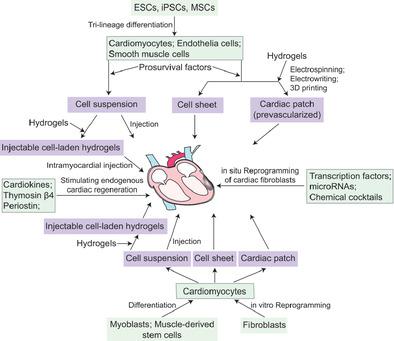当前位置:
X-MOL 学术
›
Adv. Healthcare Mater.
›
论文详情
Our official English website, www.x-mol.net, welcomes your
feedback! (Note: you will need to create a separate account there.)
Cardiomyocyte Induction and Regeneration for Myocardial Infarction Treatment: Cell Sources and Administration Strategies
Advanced Healthcare Materials ( IF 10.0 ) Pub Date : 2020-10-01 , DOI: 10.1002/adhm.202001175 Lihong He 1 , Xiongbiao Chen 2
Advanced Healthcare Materials ( IF 10.0 ) Pub Date : 2020-10-01 , DOI: 10.1002/adhm.202001175 Lihong He 1 , Xiongbiao Chen 2
Affiliation

|
Occlusion of coronary artery and subsequent damage or death of myocardium can lead to myocardial infarction (MI) and even heart failure—one of the leading causes of deaths world wide. Notably, myocardium has extremely limited regeneration potential due to the loss or death of cardiomyocytes (i.e., the cells of which the myocardium is comprised) upon MI. A variety of stem cells and stem cell‐derived cardiovascular cells, in situ cardiac fibroblasts and endogenous proliferative epicardium, have been exploited to provide renewable cellular sources to treat injured myocardium. Also, different strategies, including direct injection of cell suspensions, bioactive molecules, or cell‐incorporated biomaterials, and implantation of artificial cardiac scaffolds (e.g., cell sheets and cardiac patches), have been developed to deliver renewable cells and/or bioactive molecules to the MI site for the myocardium regeneration. This article briefly surveys cell sources and delivery strategies, along with biomaterials and their processing techniques, developed for MI treatment. Key issues and challenges, as well as recommendations for future research, are also discussed.
中文翻译:

心肌梗死治疗的心肌细胞诱导和再生:细胞来源和给药策略
冠状动脉的阻塞以及随后的心肌损伤或死亡会导致心肌梗塞(MI)甚至心脏衰竭,这是全球范围内死亡的主要原因之一。值得注意的是,由于心肌梗死后心肌细胞(即构成心肌的细胞)的丢失或死亡,心肌具有极有限的再生潜力。已利用各种干细胞和干细胞衍生的心血管细胞,原位心脏成纤维细胞和内源性增生性心外膜提供可再生的细胞来源,以治疗受损的心肌。此外,还有不同的策略,包括直接注射细胞悬液,生物活性分子或细胞掺入的生物材料,以及植入人工心脏支架(例如细胞片和心脏贴片),已经开发出将可再生细胞和/或生物活性分子递送至MI部位以进行心肌再生的技术。本文简要概述了为MI治疗开发的细胞来源和递送策略,以及生物材料及其加工技术。还讨论了关键问题和挑战以及对未来研究的建议。
更新日期:2020-11-18
中文翻译:

心肌梗死治疗的心肌细胞诱导和再生:细胞来源和给药策略
冠状动脉的阻塞以及随后的心肌损伤或死亡会导致心肌梗塞(MI)甚至心脏衰竭,这是全球范围内死亡的主要原因之一。值得注意的是,由于心肌梗死后心肌细胞(即构成心肌的细胞)的丢失或死亡,心肌具有极有限的再生潜力。已利用各种干细胞和干细胞衍生的心血管细胞,原位心脏成纤维细胞和内源性增生性心外膜提供可再生的细胞来源,以治疗受损的心肌。此外,还有不同的策略,包括直接注射细胞悬液,生物活性分子或细胞掺入的生物材料,以及植入人工心脏支架(例如细胞片和心脏贴片),已经开发出将可再生细胞和/或生物活性分子递送至MI部位以进行心肌再生的技术。本文简要概述了为MI治疗开发的细胞来源和递送策略,以及生物材料及其加工技术。还讨论了关键问题和挑战以及对未来研究的建议。










































 京公网安备 11010802027423号
京公网安备 11010802027423号